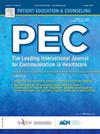Equivocation in patients’ decisional preference about life-sustaining treatments
IF 3.1
2区 医学
Q2 PUBLIC, ENVIRONMENTAL & OCCUPATIONAL HEALTH
引用次数: 0
Abstract
Objective
Communication is essential for achieving shared decision-making. We focus on how patients design decisional preferences to allow or decline life-sustaining treatments (LST). We examine “equivocation”, a practice through which patients refer to two preferences in response to the physician asking for only one.
Methods
Conversation analysis of 89 conversations with physicians in which patients allow or decline LST.
Results
We identified three types of decisional preference formats. In “unequivocal preferences”, patients express a clear-cut preference towards or against an intervention. In “implicitly equivocal preferences” patients express one preference accompanied by a conditional account, conveying an implicit caveat: if the condition is not fulfilled, the preference is not valid. In “explicitly equivocal preferences”, patients refer to two contrasting options.
Conclusion
These constructions reveal the complexity of decision-making and its granularity, as patients orient to particular scenarios that make relevant specific approaches, instead of confining decisional preferences to the polar request design employed by the physician.
Practice Implications
Equivocal answers are not always acknowledged by physicians, which means that the documentation of patients’ preferences might not adequately capture their wishes and expectations. This pattern of response also raises issues about what patients agree to and understand and, more generally, about patient literacy.
患者对维持生命治疗决策偏好的模棱两可
目的沟通是实现共同决策的必要条件。我们关注患者如何设计决策偏好来允许或拒绝生命维持治疗(LST)。我们检查“模棱两可”,通过这种做法,患者参考两种偏好,以回应医生要求只有一个。方法对89例患者允许或拒绝LST的医生谈话进行对话分析。结果我们确定了三种类型的决策偏好格式。在“明确的偏好”中,患者明确表达了对干预措施的偏好。在“隐含模棱两可的偏好”中,患者表达了一种偏好,并附带了一个条件说明,传达了一个隐含的警告:如果条件不满足,这种偏好是无效的。在“明确模棱两可的偏好”中,患者指的是两种截然不同的选择。这些结构揭示了决策的复杂性及其粒度,因为患者倾向于制定相关具体方法的特定场景,而不是将决策偏好限制在医生采用的极性请求设计中。实践意义不明确的答案并不总是得到医生的认可,这意味着对患者偏好的记录可能不能充分反映他们的愿望和期望。这种反应模式也引发了关于患者同意和理解的问题,更普遍地说,关于患者素养的问题。
本文章由计算机程序翻译,如有差异,请以英文原文为准。
求助全文
约1分钟内获得全文
求助全文
来源期刊

Patient Education and Counseling
医学-公共卫生、环境卫生与职业卫生
CiteScore
5.60
自引率
11.40%
发文量
384
审稿时长
46 days
期刊介绍:
Patient Education and Counseling is an interdisciplinary, international journal for patient education and health promotion researchers, managers and clinicians. The journal seeks to explore and elucidate the educational, counseling and communication models in health care. Its aim is to provide a forum for fundamental as well as applied research, and to promote the study of organizational issues involved with the delivery of patient education, counseling, health promotion services and training models in improving communication between providers and patients.
 求助内容:
求助内容: 应助结果提醒方式:
应助结果提醒方式:


